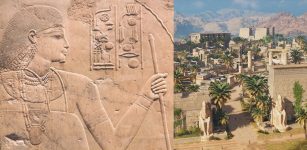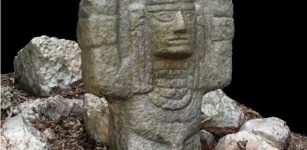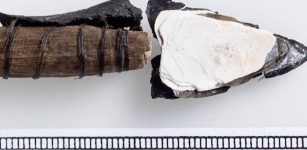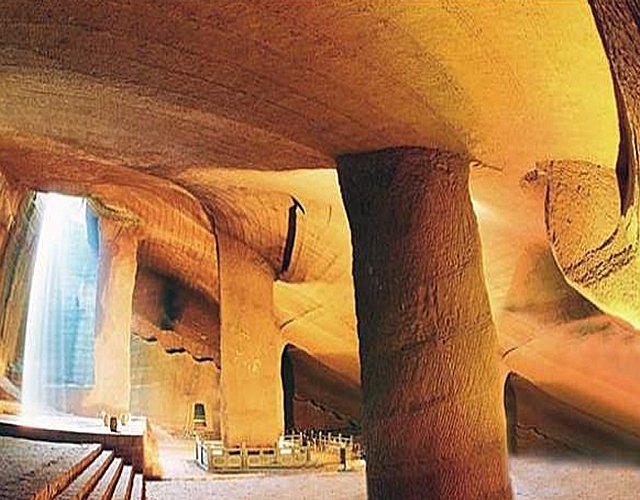Underground Man-Made Longyou Grottoes Remain An Ancient Unsolved Mystery
A. Sutherland - AncientPages.com - Fascinating and mysterious underground Longyou Grottoes (also known as Longyou Caves) must have been some kind of an extraordinary man-made project of the ancient skilled builders, who created them more than 2000 years ago.
They have long been the subject of great fascination for both scholars and laymen alike but until now, no one was able to solve the mystery of their creation.
Researchers from several countries around the world visited and investigated the Longyou Grottoes, which are believed to date to a period before the creation of the Qin Dynasty in 212 BCE
Description Of The Caves
The caves are very large considering their man-made origin: the average floor area of each cave is over a 1,000 square meters(11,000 sq ft), with heights of up to 30 meters(98 ft), and the total area covered is in excess of 30,000 square meters (320,000 sq ft).
The ceiling, wall and pillar surfaces are all finished in the same manner, as a series of parallel bands or courses about 60 cm wide containing parallel chiselling marks set at an angle of about 60° to the axis of the course. They have maintained their structural integrity and appear not to interconnect with each other.
The areas of grottoes differ from 1,000 to 3,000 square meters. Each grotto makes a downward vertical extension from the rectangular hole with a height of approximately 30 meters.
The Longyou Grottoes are located at Phoenix Hill, 3 km north from Longyou County Quzhou prefecture, Zhejiang province, China.
Anonymous Builders, Unknown Purpose Of Construction
Unfortunately, there are no historical records of their construction, no construction plans or methods of their design have ever been found.
Why have these large artificial sandstone structures been able to maintain the stability for so long? Were they constructed by ancient Chinese or an unknown very advanced civilization present in the region at that time?
Decorated With Lines And Symbols
The walls, roof, and stone columns of each of the grottoes are decorated with chisel marks - lines and symbols - probably deliberately left by the ancients.
Do these symbols have only ornamental purpose or are there a hidden message within the walls that has yet to be deciphered?
Among twenty-four discovered grottoes - all of which were carved by hand - there are seven that are decorated with patterns clearly resembling the seven stars of the Big Dipper.
None of the caves are connected with each other, but many of them share thin walls. As Yang Hongxun, an expert at the Archaeological Institute of Chinese Academy of Social Sciences, explained "at the bottom of each cave, the ancient builders wouldn't be able to see what the others were doing in the next grotto. But the inside of each cave had to be parallel with that of the other, or else the wall would be holed through.
See also:
Unanswered Questions Related To The Mysterious Huashan Caves
Ancient Secrets Hidden In The Piyang Caves - Mysterious Sacred Caves Of Tibet
Thus the measuring apparatus should have been very advanced. There must have been some layout about the sizes, locations, and the distances between the caves beforehand."
Many questions regarding the Longyou masterwork have never been answered. Where was the excavated rock from the grottoes transported?
How many workers were involved in the creation of these extremely sophisticated grottoes?
The four caves, for example, cover an average floor surface of 1,200 square meters, so each of the caves should have involved the excavation of 36,000 cubic meters of stone. Since a total of 24 such caves have already been found in Shiyanbei Village, the overall excavation would be 900,000 cubic meters.
Could Ancient Chinese Build Them?
According to an estimation: if one man can dig and carry out 0.5 cubic meters of stone every day, then building these 24 caves would require 1,000 strong men to work 24 hours a day, seven days a week for about 5 years. However, this is only a conservative estimation, because the deeper the cave goes, the more difficult in excavation and transportation will be.'
One theory suggests that large rock grottoes fully filled with water can be stable and integrate for a thousand years. Other issues must wait for answers.
Modern rock mechanics and rock engineering are younger than 100 years and have never contributed to this kind of very advanced constructions.
More on rock mechanics and rock engineering.
Written by – A. Sutherland - AncientPages.com Senior Staff Writer
Copyright © AncientPages.com All rights reserved. This material may not be published, broadcast, rewritten or redistributed in whole or part without the express written permission of AncientPages.com
More From Ancient Pages
-
 Jiangshi – Terrifying Vicious Ancient Chinese Vampire In Disguise
Chinese Mythology | Jun 11, 2020
Jiangshi – Terrifying Vicious Ancient Chinese Vampire In Disguise
Chinese Mythology | Jun 11, 2020 -
 Unexplained Encounters With Invisible Barriers – Mysterious Rays And Energy Fields
Featured Stories | Jul 17, 2018
Unexplained Encounters With Invisible Barriers – Mysterious Rays And Energy Fields
Featured Stories | Jul 17, 2018 -
 Shishak (Sheshonq I): Egyptian King Who Invaded Judah And United Egypt
Featured Stories | Feb 28, 2019
Shishak (Sheshonq I): Egyptian King Who Invaded Judah And United Egypt
Featured Stories | Feb 28, 2019 -
 Reconstruction Of Five-Story Patara Lighthouse Built By Roman Emperor Nero – Begins
Archaeology | May 30, 2019
Reconstruction Of Five-Story Patara Lighthouse Built By Roman Emperor Nero – Begins
Archaeology | May 30, 2019 -
 3,000-Year-Old Fortress Built By The Mysterious Votadini Tribe Discovered On Top Of Arthur’s Seat
Archaeology | Sep 11, 2020
3,000-Year-Old Fortress Built By The Mysterious Votadini Tribe Discovered On Top Of Arthur’s Seat
Archaeology | Sep 11, 2020 -
 Master Kong Confucius: Great Philosopher And ‘Teacher Of All Teachers’ Ahead Of His Time
Featured Stories | Nov 25, 2016
Master Kong Confucius: Great Philosopher And ‘Teacher Of All Teachers’ Ahead Of His Time
Featured Stories | Nov 25, 2016 -
 Oldest Indo-European Calendar Based On The Orion Constellation Is Engraved On A Vucedol Vessel
Artifacts | Jun 7, 2021
Oldest Indo-European Calendar Based On The Orion Constellation Is Engraved On A Vucedol Vessel
Artifacts | Jun 7, 2021 -
 Ancient Mystery Of The Strange, Small Underground Being Who Secretly Emptied Casks
Featured Stories | Dec 8, 2024
Ancient Mystery Of The Strange, Small Underground Being Who Secretly Emptied Casks
Featured Stories | Dec 8, 2024 -
 Why Did Ancient Egyptians Fear The Vizier?
Ancient History Facts | May 24, 2018
Why Did Ancient Egyptians Fear The Vizier?
Ancient History Facts | May 24, 2018 -
 Find Out Which Indigenous Lands You Live On With This Interactive Map Covering The Whole World
Places | Jan 17, 2023
Find Out Which Indigenous Lands You Live On With This Interactive Map Covering The Whole World
Places | Jan 17, 2023 -
 Ancient Atlantean Sculpture Discovered At The Mayan Chichen Itza Archaeological Site
Archaeology | Aug 29, 2023
Ancient Atlantean Sculpture Discovered At The Mayan Chichen Itza Archaeological Site
Archaeology | Aug 29, 2023 -
 Unique Ancient Artifacts Discovered In Melting Ice Patches In Norway
Archaeology | May 19, 2022
Unique Ancient Artifacts Discovered In Melting Ice Patches In Norway
Archaeology | May 19, 2022 -
 Treasure Trove Of Spices Found On The Sunken Medieval Ship Gribshunden
Archaeology | Feb 11, 2023
Treasure Trove Of Spices Found On The Sunken Medieval Ship Gribshunden
Archaeology | Feb 11, 2023 -
 The Oseberg Tapestry And Other Artifacts Show Intense Colors Were A Viking Symbol Of Status And Wealth
Featured Stories | Sep 27, 2021
The Oseberg Tapestry And Other Artifacts Show Intense Colors Were A Viking Symbol Of Status And Wealth
Featured Stories | Sep 27, 2021 -
 Drones Find Evidence Roman Siege Of Masada Lasted Much Shorter Than Previously Thought
Archaeology | Sep 6, 2024
Drones Find Evidence Roman Siege Of Masada Lasted Much Shorter Than Previously Thought
Archaeology | Sep 6, 2024 -
 Medieval Burials Discovered Under London’s Westminster Abbey
News | Sep 24, 2015
Medieval Burials Discovered Under London’s Westminster Abbey
News | Sep 24, 2015 -
 Red And Black Ink Used In Egyptian Papyri Reveal Ancient Writing Practices
News | Oct 27, 2020
Red And Black Ink Used In Egyptian Papyri Reveal Ancient Writing Practices
News | Oct 27, 2020 -
 Jack o’ Legs – The Kind Hertfordshire Giant Who Robbed The Rich And Gave To The Poor
Featured Stories | Sep 20, 2021
Jack o’ Legs – The Kind Hertfordshire Giant Who Robbed The Rich And Gave To The Poor
Featured Stories | Sep 20, 2021 -
 Devil’s Advocate – Ancient Phrase Traced To The Roman Catholic Church
Ancient History Facts | Nov 19, 2018
Devil’s Advocate – Ancient Phrase Traced To The Roman Catholic Church
Ancient History Facts | Nov 19, 2018 -
 Late Roman-Era Rooms, Offering Vessels Unearthed At Ancient City Of Antiocheia, Southern Türkiye
Archaeology | Oct 31, 2022
Late Roman-Era Rooms, Offering Vessels Unearthed At Ancient City Of Antiocheia, Southern Türkiye
Archaeology | Oct 31, 2022





